
Meet the Buddhas
A Guide to Kadampa Shrines
Every Kadampa Center has a shrine. It provides a focus for our faith, serving as a continual reminder of the Buddhas through whose kindness living beings have the opportunity to attain permanent inner peace and the supreme happiness of enlightenment.
| • | Statues represent Buddha’s body |
| • | Dharma books represent Buddha’s speech |
| • | Stupas represent Buddha’s mind |
These representations of Buddha’s body, speech and mind are so blessed that, even if we have no faith, just seeing them blesses our mind. A modern Kadampa Buddhist shrine includes representations of four enlightened holy beings known as the Four Kadampa Guru Deities – Buddha Shakyamuni, Avalokiteshvara, Arya Tara and the Wisdom Dharma Protector.
Kadampas sincerely rely upon Buddha Shakyamuni because Buddha is the source of Kadam Lamrim; they sincerely rely upon Avalokiteshvara, the Buddha of Compassion, and upon the Wisdom Dharma Protector, indicating that their main practice is compassion and wisdom; and they sincerely rely upon Arya Tara because she promised Atisha that she would take special care of Kadampa practitioners in the future.
Tour the modern Kadampa shrine at the International Kadampa Retreat Center Grand Canyon.
 One of the best methods to increase our faith in the Buddhas and to receive their blessings is to gaze at an image of a Buddha again and again, regarding it as an actual Buddha who is supremely kind to all living beings. By viewing images of Buddhas in this way, it is as if we are opening a window in our mind through which the blessings of the holy beings can enter. This special way of viewing Buddha images is based on wisdom, not ignorance, and functions to increase our faith and receive blessings.”
One of the best methods to increase our faith in the Buddhas and to receive their blessings is to gaze at an image of a Buddha again and again, regarding it as an actual Buddha who is supremely kind to all living beings. By viewing images of Buddhas in this way, it is as if we are opening a window in our mind through which the blessings of the holy beings can enter. This special way of viewing Buddha images is based on wisdom, not ignorance, and functions to increase our faith and receive blessings.”
Geshe Kelsang Gyatso, Eight Steps to Happiness
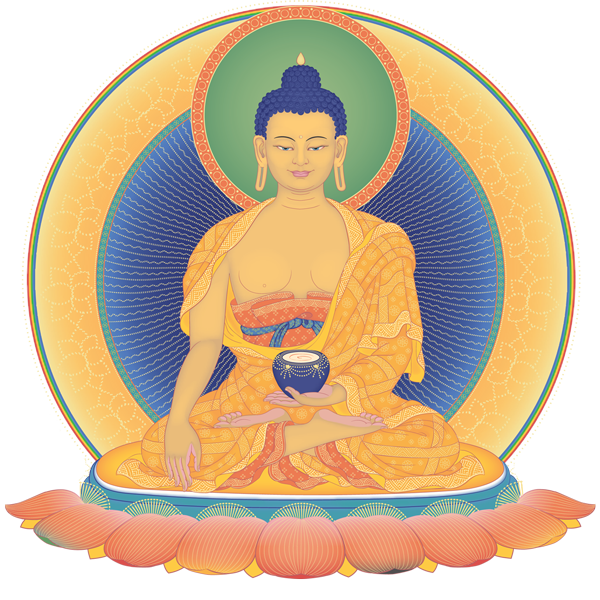 Buddha Shakyamuni is the fourth of one thousand founding Buddhas who will appear in this world during this Fortunate Eon, and the founder of Buddhism in this world. He is the principal object of refuge for all Buddhists. He is holding a begging bowl filled with three nectars indicating that he has conquered the “demons” of uncontrolled death, a contaminated body and mind, and delusions, and is touching the ground indicating his power to subdue all negative forces.
Buddha Shakyamuni is the fourth of one thousand founding Buddhas who will appear in this world during this Fortunate Eon, and the founder of Buddhism in this world. He is the principal object of refuge for all Buddhists. He is holding a begging bowl filled with three nectars indicating that he has conquered the “demons” of uncontrolled death, a contaminated body and mind, and delusions, and is touching the ground indicating his power to subdue all negative forces.
 Medicine Buddha functions to release living beings from outer and inner sickness. His body of blue wisdom light indicates that he is an emanation of the healing power of all the Buddhas; his hands hold a bowl filled with medicinal nectar and a medicinal plant. Through relying upon Medicine Buddha with faith we develop a special power of body, speech and mind, which we can use to help others through healing actions.
Medicine Buddha functions to release living beings from outer and inner sickness. His body of blue wisdom light indicates that he is an emanation of the healing power of all the Buddhas; his hands hold a bowl filled with medicinal nectar and a medicinal plant. Through relying upon Medicine Buddha with faith we develop a special power of body, speech and mind, which we can use to help others through healing actions.
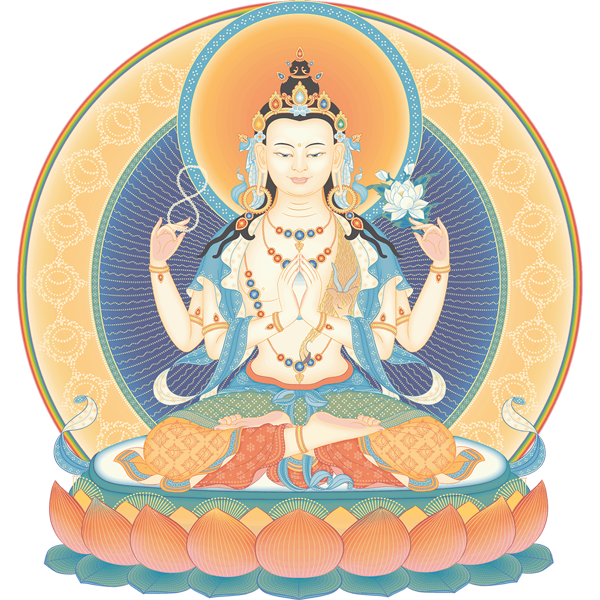 Avalokiteshvara embodies the universal compassion of all Buddhas. His first two hands pressed together at his heart symbolize respect for his Spiritual Guide, and hold a jewel symbolizing his own enlightenment. His second left hand holds a white lotus flower, symbolizing his complete purity of body, speech and mind; and his second right hand holds a crystal mala, symbolizing that he can free all living beings from samsara.
Avalokiteshvara embodies the universal compassion of all Buddhas. His first two hands pressed together at his heart symbolize respect for his Spiritual Guide, and hold a jewel symbolizing his own enlightenment. His second left hand holds a white lotus flower, symbolizing his complete purity of body, speech and mind; and his second right hand holds a crystal mala, symbolizing that he can free all living beings from samsara.
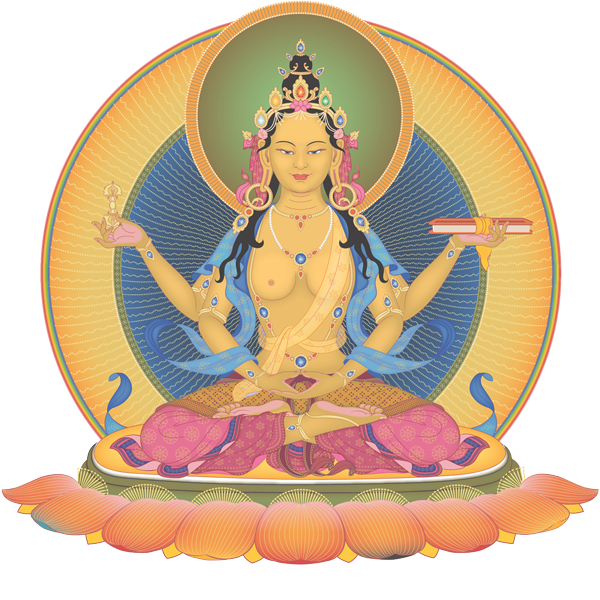 Prajnaparamita the manifestation of Buddha’s perfection of wisdom – holds a vajra and a scripture of the Perfection of Wisdom Sutra. Her remaining two hands are in the mudra of meditative equipoise. Her hands teach us that through training in meditation on the perfection of wisdom we can accomplish the higher perfection of wisdom, the union of great bliss and emptiness, through which we can attain enlightenment very quickly.
Prajnaparamita the manifestation of Buddha’s perfection of wisdom – holds a vajra and a scripture of the Perfection of Wisdom Sutra. Her remaining two hands are in the mudra of meditative equipoise. Her hands teach us that through training in meditation on the perfection of wisdom we can accomplish the higher perfection of wisdom, the union of great bliss and emptiness, through which we can attain enlightenment very quickly.
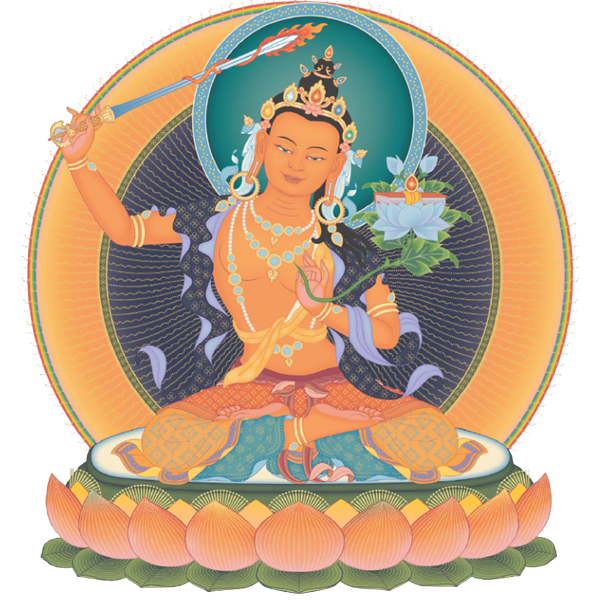 Manjushri is the Wisdom Buddha. His right hand holds a wisdom sword symbolizing his wisdom cuts through ignorance. His left, the stem of an upala flower that supports the Perfection of Wisdom Sutra, indicating that by relying on Manjushri we can develop the wisdom eye understanding the entire meaning of Buddha’s Perfection of Wisdom Sutras.
Manjushri is the Wisdom Buddha. His right hand holds a wisdom sword symbolizing his wisdom cuts through ignorance. His left, the stem of an upala flower that supports the Perfection of Wisdom Sutra, indicating that by relying on Manjushri we can develop the wisdom eye understanding the entire meaning of Buddha’s Perfection of Wisdom Sutras.
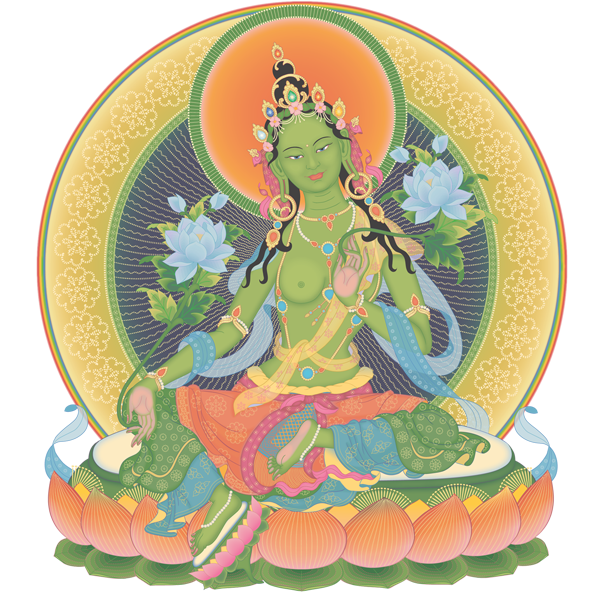 Green Tara the female Buddha of active compassion who, as the manifestation of the ultimate wisdom of all the Buddhas, is known as the ‘Mother of the Conquerors’. She is also known as the ‘Great Liberator’ who pacifies all sickness, poverty, misfortune, fighting and quarrelling, and causes the Dharma and all good fortune to flourish.
Green Tara the female Buddha of active compassion who, as the manifestation of the ultimate wisdom of all the Buddhas, is known as the ‘Mother of the Conquerors’. She is also known as the ‘Great Liberator’ who pacifies all sickness, poverty, misfortune, fighting and quarrelling, and causes the Dharma and all good fortune to flourish.
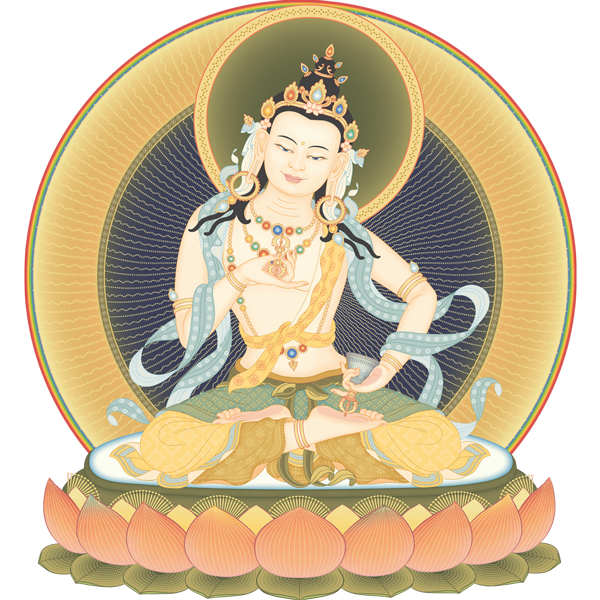 Vajrasattva the Buddha of purification, the manifestation of the minds of all the Buddhas, appears specifically to purify the negativities of living beings. He is the same nature as Buddha Vajradhara, differing only in aspect.
Vajrasattva the Buddha of purification, the manifestation of the minds of all the Buddhas, appears specifically to purify the negativities of living beings. He is the same nature as Buddha Vajradhara, differing only in aspect.
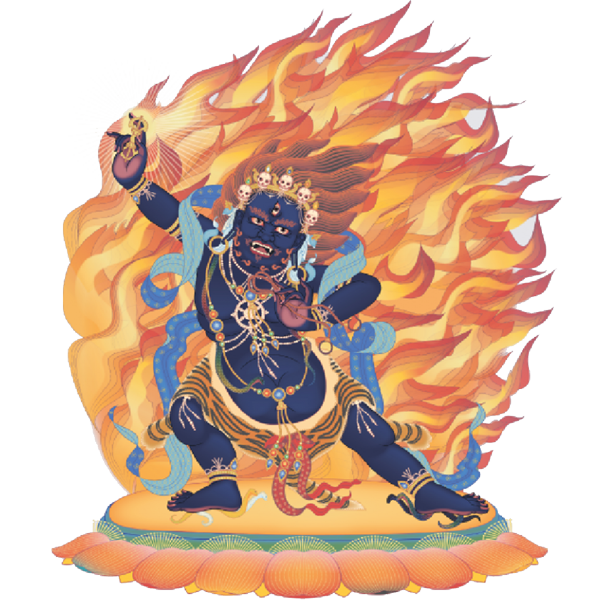 Vajrapani is a Tantric enlightened being who bestows special power on our body and mind. Through receiving his blessings we will develop the inner strength to overcome our daily problems and sufferings, and to eliminate our delusions, especially our self-grasping ignorance.
Vajrapani is a Tantric enlightened being who bestows special power on our body and mind. Through receiving his blessings we will develop the inner strength to overcome our daily problems and sufferings, and to eliminate our delusions, especially our self-grasping ignorance.
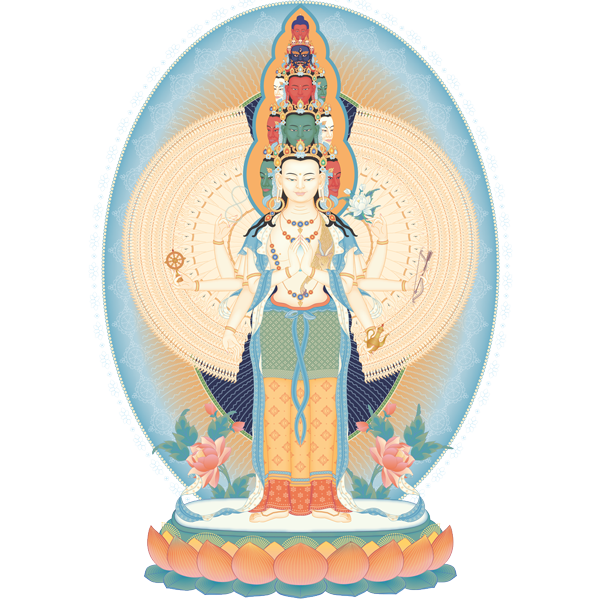 1,000 Armed Avalokiteshvara embodies universal compassion. His eleven faces (ten for his emanations of the ten directions and his root Guru, Buddha Amitabha) indicate he benefits living beings through countless emanations. A thousand arms indicate he’s the synthesis of the thousand Buddhas of this Fortunate Eon. Eyes in each palm indicate he watches over and cares for infinite living beings.
1,000 Armed Avalokiteshvara embodies universal compassion. His eleven faces (ten for his emanations of the ten directions and his root Guru, Buddha Amitabha) indicate he benefits living beings through countless emanations. A thousand arms indicate he’s the synthesis of the thousand Buddhas of this Fortunate Eon. Eyes in each palm indicate he watches over and cares for infinite living beings.
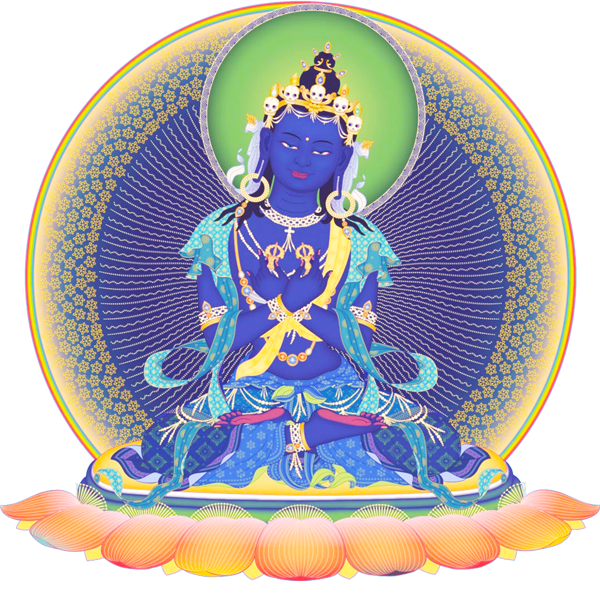 Vajradhara is the founder of Vajrayana Buddhism, or Tantra, and the source of all the Tantric teachings. He is the same mental continuum as Buddha Shakyamuni but displays a different aspect. Buddha Shakyamuni appears in the aspect of an Emanation Body, and Buddha Vajradhara appears in the aspect of an Enjoyment Body.
Vajradhara is the founder of Vajrayana Buddhism, or Tantra, and the source of all the Tantric teachings. He is the same mental continuum as Buddha Shakyamuni but displays a different aspect. Buddha Shakyamuni appears in the aspect of an Emanation Body, and Buddha Vajradhara appears in the aspect of an Enjoyment Body.
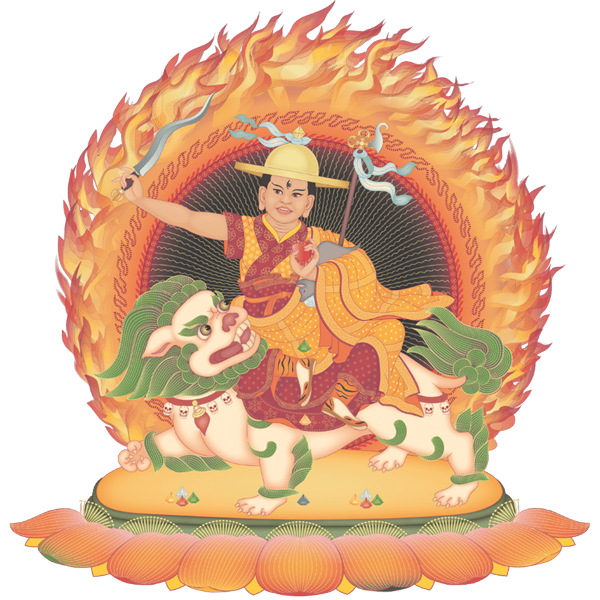 Dorje Shugden is a Buddha appearing in a protecting aspect, whose main functions are to avert inner and outer obstacles that prevent practitioners from gaining spiritual realizations, and to arrange all the necessary conditions for their spiritual development. The Dharma Protector Dorje Shugden is an emanation of the Wisdom Buddha Manjushri.
Dorje Shugden is a Buddha appearing in a protecting aspect, whose main functions are to avert inner and outer obstacles that prevent practitioners from gaining spiritual realizations, and to arrange all the necessary conditions for their spiritual development. The Dharma Protector Dorje Shugden is an emanation of the Wisdom Buddha Manjushri.
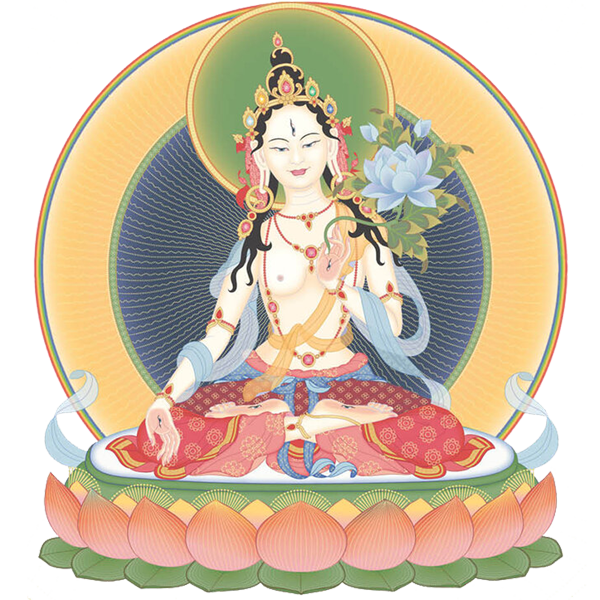 White Tara is an enlightened being whose function is to bestow long life, wisdom and good fortune. If we rely upon her with faith, she will protect us from contagious diseases, the dangers of fire, and other disasters, as well as from untimely death. Ultimately she will guide us to the deathless state of Buddhahood.
White Tara is an enlightened being whose function is to bestow long life, wisdom and good fortune. If we rely upon her with faith, she will protect us from contagious diseases, the dangers of fire, and other disasters, as well as from untimely death. Ultimately she will guide us to the deathless state of Buddhahood.
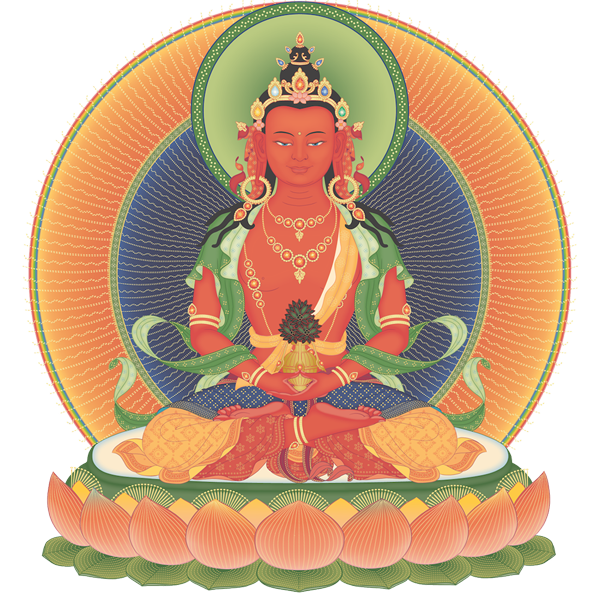 Amitayus the Buddha of long life, wisdom, and merit – has a red-colored body and sits with his two hands in the gesture of meditative equipoise, holding a vase filled with nectar of immortality. Amitayus is the Enjoyment Body aspect of Buddha Amitabha. He is seated on a throne supported by peacocks indicating his connection with Buddha Amitabha.
Amitayus the Buddha of long life, wisdom, and merit – has a red-colored body and sits with his two hands in the gesture of meditative equipoise, holding a vase filled with nectar of immortality. Amitayus is the Enjoyment Body aspect of Buddha Amitabha. He is seated on a throne supported by peacocks indicating his connection with Buddha Amitabha.
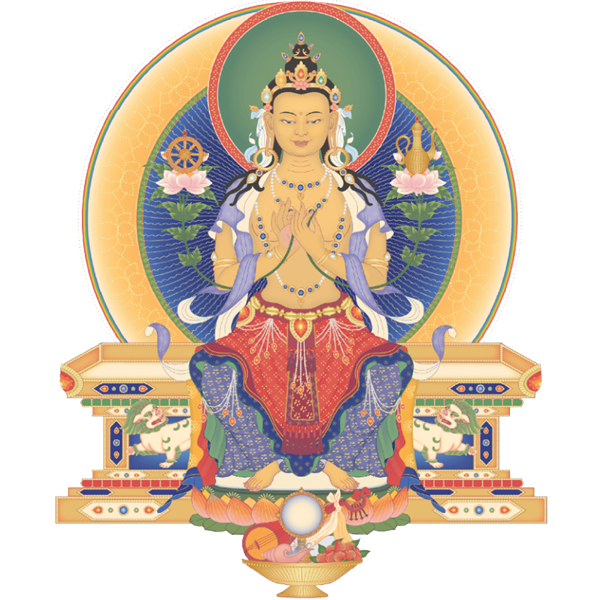 Maitreya is the Buddha of loving-kindness. His hands are in the gesture of teaching Dharma, holding two lotuses symbolizing his omniscient wisdom. The lotus on his right supports the Wheel of Dharma and the vase on his left is filled with life-giving nectars. On his crown is a stupa symbolizing his Spiritual Guide, Buddha Shakyamuni.
Maitreya is the Buddha of loving-kindness. His hands are in the gesture of teaching Dharma, holding two lotuses symbolizing his omniscient wisdom. The lotus on his right supports the Wheel of Dharma and the vase on his left is filled with life-giving nectars. On his crown is a stupa symbolizing his Spiritual Guide, Buddha Shakyamuni.
 Vajrayogini is a female enlightened Deity of Highest Yoga Tantra. She is standing on worldly deities demonstrating that she has destroyed attachment, hatred and ignorance. Her body is in the nature of the perfection of wisdom of all the Buddhas, and her five adornments are the other five perfections of all the Buddhas.
Vajrayogini is a female enlightened Deity of Highest Yoga Tantra. She is standing on worldly deities demonstrating that she has destroyed attachment, hatred and ignorance. Her body is in the nature of the perfection of wisdom of all the Buddhas, and her five adornments are the other five perfections of all the Buddhas.
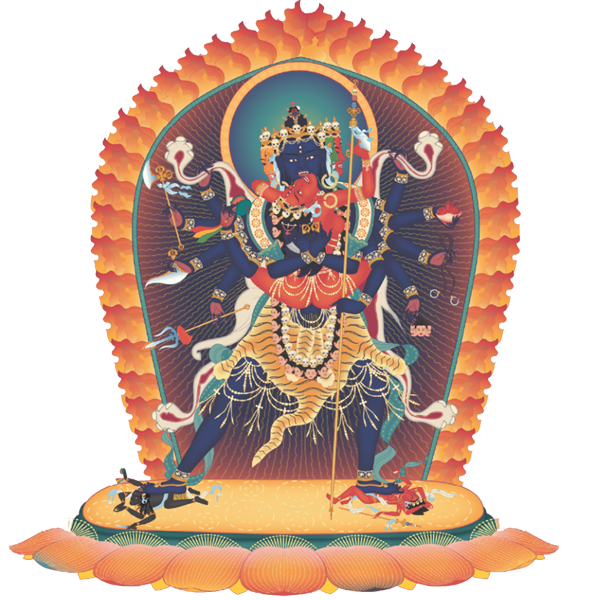 Heruka an enlightened Deity of Highest Yoga Tantra, is the manifestation of the compassion of all Buddhas. He embodies the union of the very subtle mind and emptiness – the ultimate nature of all things—the way things actually exist – as symbolized by his embracing Vajravarahi. Aspects of his body reveal the basis we need to abandon, the spiritual path we need to practice, and the result we need to accomplish.
Heruka an enlightened Deity of Highest Yoga Tantra, is the manifestation of the compassion of all Buddhas. He embodies the union of the very subtle mind and emptiness – the ultimate nature of all things—the way things actually exist – as symbolized by his embracing Vajravarahi. Aspects of his body reveal the basis we need to abandon, the spiritual path we need to practice, and the result we need to accomplish.
The Lineage of Kadampa Buddhism
In the word Kadampa, ‘Ka’ refers to Buddha’s teachings and ‘dam’ refers to Atisha’s instructions on Lamrim (the Stages of the Path to Enlightenment, also known as Kadam Lamrim). ‘Kadam’ therefore refers to the union of Buddha’s teachings and Atisha’s instructions, and sincere practitioners of Kadam Lamrim are called Kadampas.
Buddha Shakyamuni | circa 450 BC
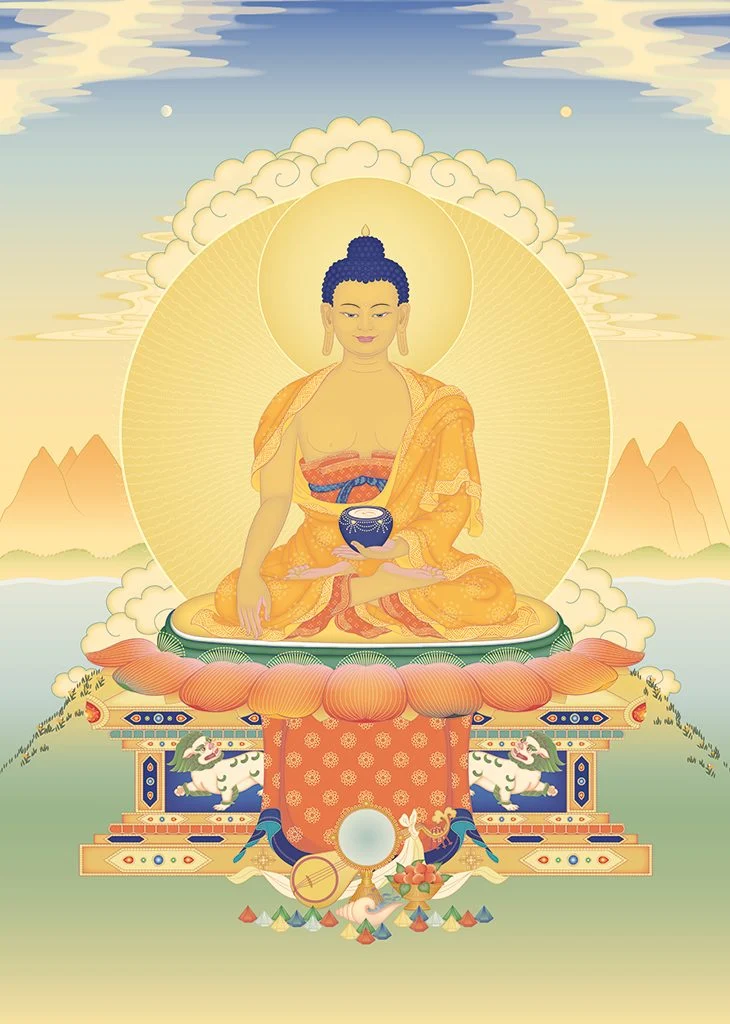 Buddha Shakyamuni is the founder of the Buddhist religion. Buddha is the fourth of one thousand founding Buddhas who are to appear in this world during this Fortunate Aeon. The first three were Krakuchchanda, Kanakamuni, and Kashyapa. The fifth Buddha will be Maitreya.
Buddha Shakyamuni is the founder of the Buddhist religion. Buddha is the fourth of one thousand founding Buddhas who are to appear in this world during this Fortunate Aeon. The first three were Krakuchchanda, Kanakamuni, and Kashyapa. The fifth Buddha will be Maitreya.
Atisha | 982-1054
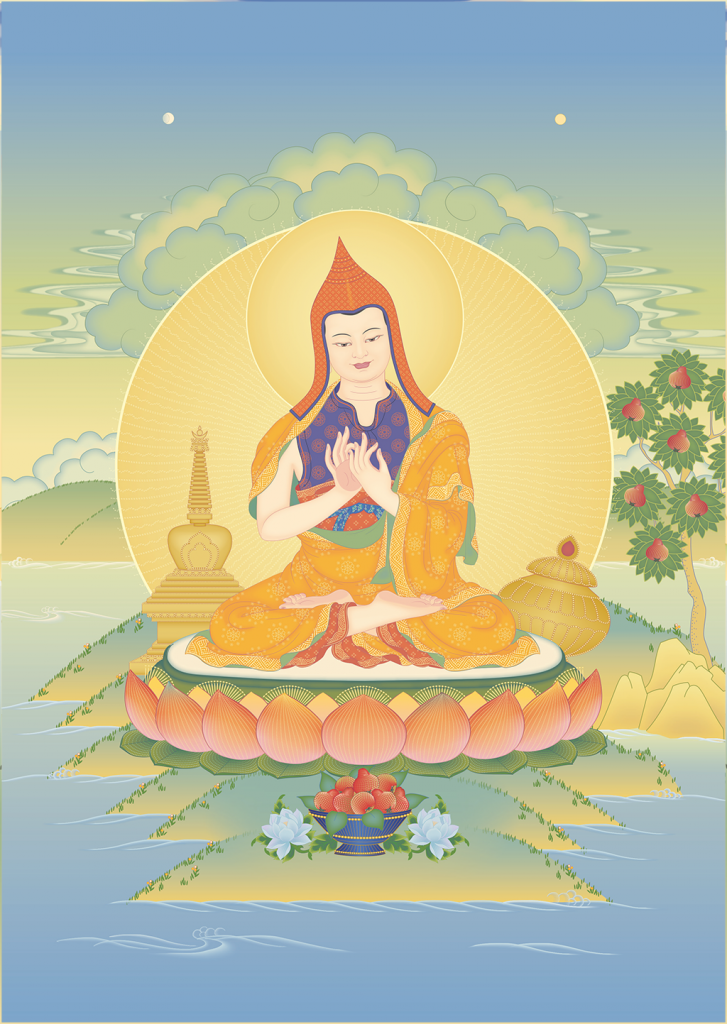 Atisha is the great Buddhist Master and scholar who founded the Kadampa tradition and who re-established Buddhism in Tibet. He composed and taught Lamp for the Path to Enlightenment, the first text written on the stages of the path, Lamrim.
Atisha is the great Buddhist Master and scholar who founded the Kadampa tradition and who re-established Buddhism in Tibet. He composed and taught Lamp for the Path to Enlightenment, the first text written on the stages of the path, Lamrim.
Je Tsongkhapa | 1357-1419
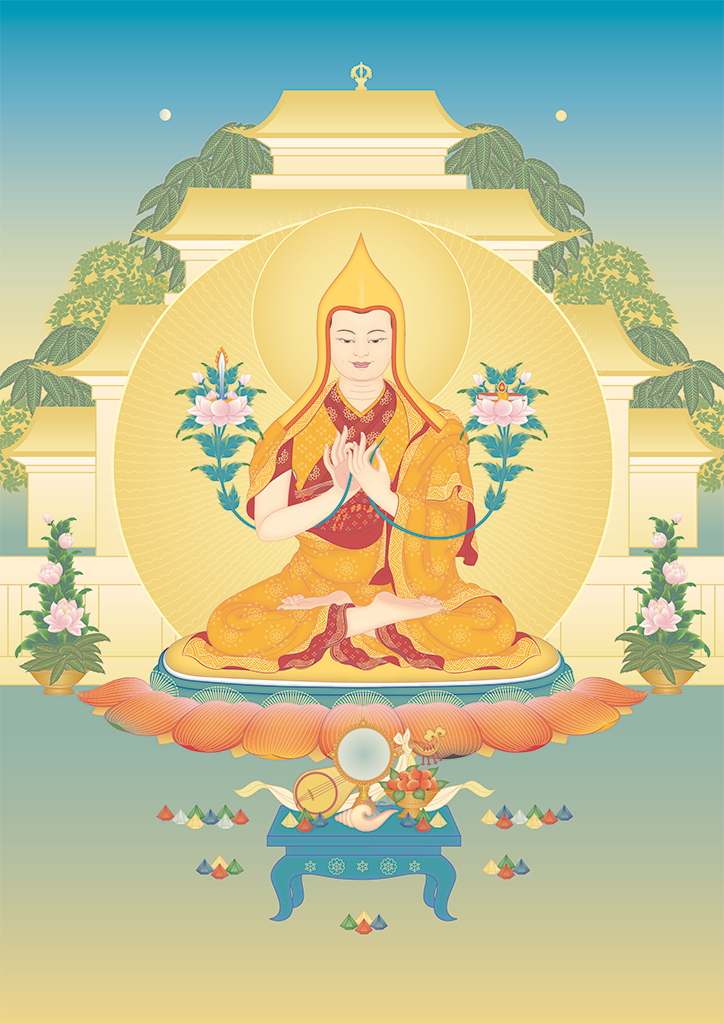 Je Tsongkhapa was a great Tibetan Buddhist Master who showed how to combine the practices of Sutra and Tantra. He was an emanation of the Wisdom Buddha Manjushri – indicated by the Wisdom Sword to his left and the Perfection of Wisdom Sutra to his right. His tradition later became known as the new Kadampa Tradition.
Je Tsongkhapa was a great Tibetan Buddhist Master who showed how to combine the practices of Sutra and Tantra. He was an emanation of the Wisdom Buddha Manjushri – indicated by the Wisdom Sword to his left and the Perfection of Wisdom Sutra to his right. His tradition later became known as the new Kadampa Tradition.
Je Phabongkhapa | 1878-1941
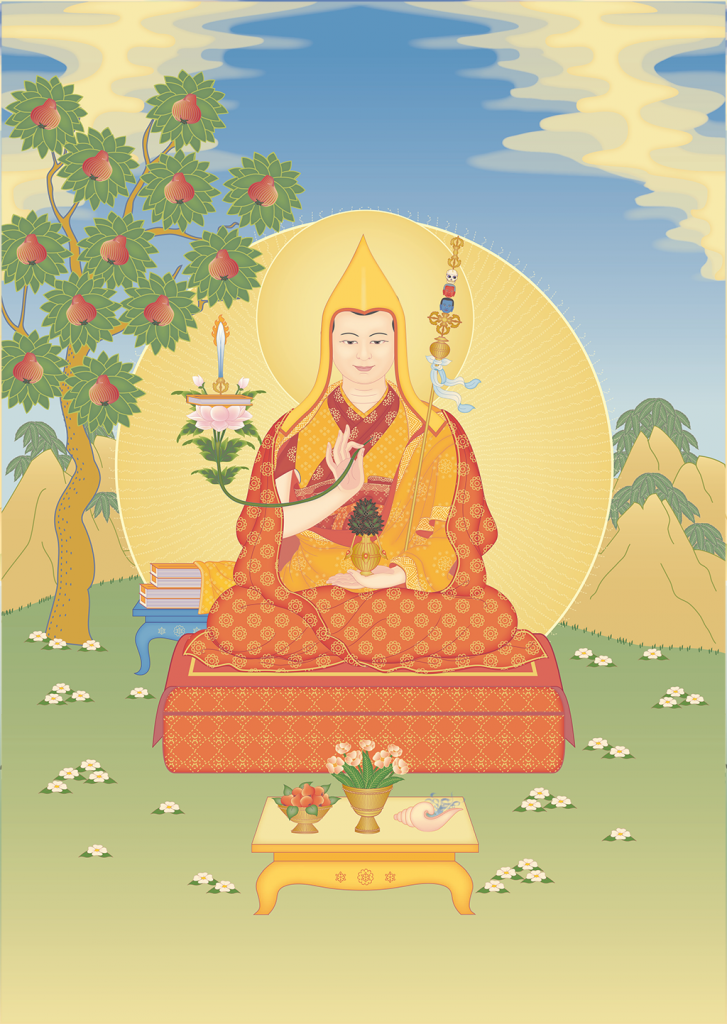 Phabongkha Rinpoche was a great Tibetan Lama who was an emanation of Heruka. Phabongkha Rinpoche was the holder of many lineages of Sutra and Secret Mantra. He was the root Guru of Yongdzin Trijang Dorjechang (Trijang Rinpoche).
Phabongkha Rinpoche was a great Tibetan Lama who was an emanation of Heruka. Phabongkha Rinpoche was the holder of many lineages of Sutra and Secret Mantra. He was the root Guru of Yongdzin Trijang Dorjechang (Trijang Rinpoche).
Trijang Rinpoche | 1901-1981
 Trijang Rinpoche was a special Tibetan Lama of the twentieth century who was an emanation of Buddha Shakyamuni, Heruka, Atisha, Amitabha, and Je Tsongkhapa. Also known as `Trijang Dorjechang’ and `Losang Yeshe’.
Trijang Rinpoche was a special Tibetan Lama of the twentieth century who was an emanation of Buddha Shakyamuni, Heruka, Atisha, Amitabha, and Je Tsongkhapa. Also known as `Trijang Dorjechang’ and `Losang Yeshe’.
Geshe Kelsang Gyatso | 1931-2022
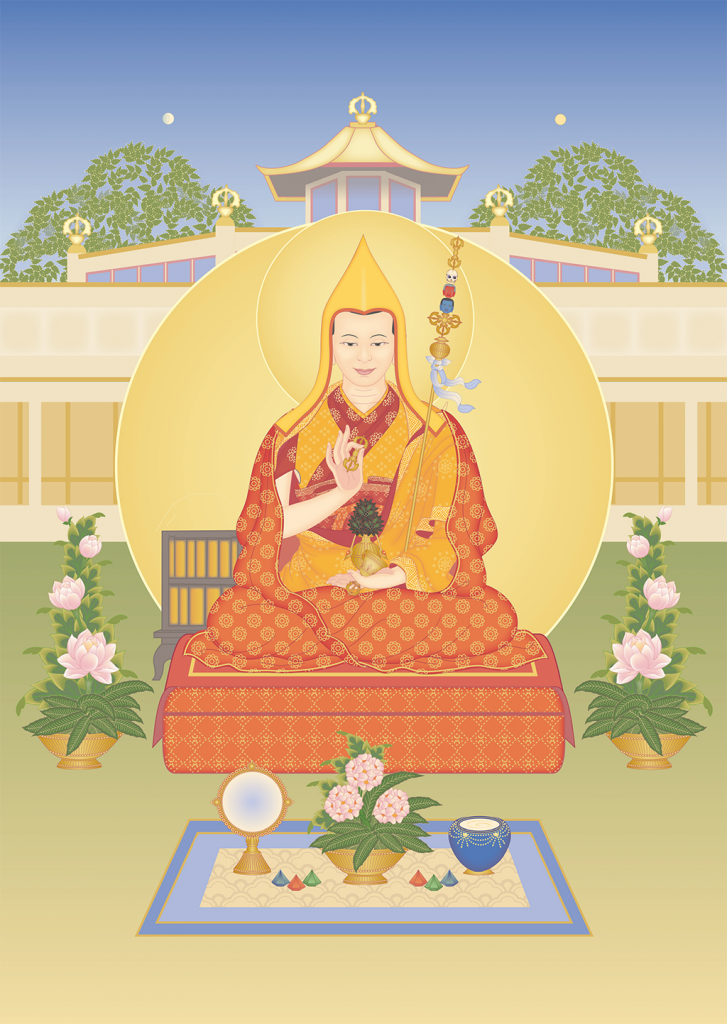 Venerable Geshe Kelsang was a fully accomplished Buddhist Master and internationally renowned Teacher, and founder of the New Kadampa Tradition. He is the author of 21 highly acclaimed books that transmit perfectly the ancient wisdom of Buddhism to our modern world, and established Kadampa Meditation Centers and Temples throughout the world. (read more…)
Venerable Geshe Kelsang was a fully accomplished Buddhist Master and internationally renowned Teacher, and founder of the New Kadampa Tradition. He is the author of 21 highly acclaimed books that transmit perfectly the ancient wisdom of Buddhism to our modern world, and established Kadampa Meditation Centers and Temples throughout the world. (read more…)
How to Set Up a Shrine
The Eight Auspicious Symbols
Inside the Kadampa World Peace Temples, and centers throughout the world, are the Eight Auspicious Symbols. These symbols show how to progress along that Buddhist path that leads to freedom from suffering and the permanent inner peace of enlightenment. It is very meaningful to memorize the profound meaning of each symbol based on Venerable Geshe Kelsang Gyatso’s explanation.
The Precious Umbrella
 To progress on the path to enlightenment we first come under the umbrella of Buddhism by going for refuge to the Three Jewels – Buddha, Dharma and Sangha.
To progress on the path to enlightenment we first come under the umbrella of Buddhism by going for refuge to the Three Jewels – Buddha, Dharma and Sangha.
The Precious Fish
 The Precious Fish symbolize peace and harmony, indicating that having come under the umbrella of Buddhism we should always maintain harmony and joy.
The Precious Fish symbolize peace and harmony, indicating that having come under the umbrella of Buddhism we should always maintain harmony and joy.
The Precious Vase
 The Precious Vase symbolizes wealth and encourages us to take the precious jewels of wisdom and compassion from the treasure vase of Kadam Dharma.
The Precious Vase symbolizes wealth and encourages us to take the precious jewels of wisdom and compassion from the treasure vase of Kadam Dharma.
The Precious Lotus
 The Precious Lotus symbolizes purity, encouraging us to enjoy the purity of our mind and actions.
The Precious Lotus symbolizes purity, encouraging us to enjoy the purity of our mind and actions.
The Precious Conch Shell
 The Precious Conch Shell symbolizes the Dharma Jewel, encouraging us to listen to precious Dharma teachings and contemplate and meditate on their meaning.
The Precious Conch Shell symbolizes the Dharma Jewel, encouraging us to listen to precious Dharma teachings and contemplate and meditate on their meaning.
The Precious Indestructible Knot
 The Precious Indestructible Knot symbolizes Buddha’s realization of omniscient wisdom and encourages us to apply great effort to attain enlightenment.
The Precious Indestructible Knot symbolizes Buddha’s realization of omniscient wisdom and encourages us to apply great effort to attain enlightenment.
The Precious Victory Banner

The Precious Dharma Wheel
 The Precious Dharma Wheel encourages us to benefit others by turning the Wheel of Dharma, that is, by giving Dharma teachings. This is our final goal.
The Precious Dharma Wheel encourages us to benefit others by turning the Wheel of Dharma, that is, by giving Dharma teachings. This is our final goal.
Questions? Feedback?
We’d love to hear from you!
